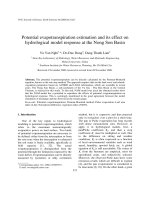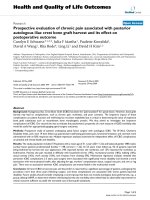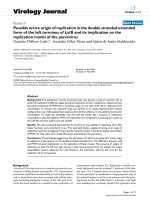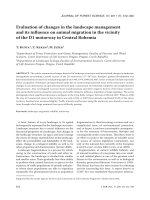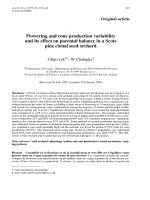Geographical distribution of fluoride and its effect on animal health
Bạn đang xem bản rút gọn của tài liệu. Xem và tải ngay bản đầy đủ của tài liệu tại đây (160.18 KB, 7 trang )
Int.J.Curr.Microbiol.App.Sci (2018) 7(3): 2871-2877
International Journal of Current Microbiology and Applied Sciences
ISSN: 2319-7706 Volume 7 Number 03 (2018)
Journal homepage:
Original Research Article
/>
Geographical Distribution of Fluoride and Its Effect on Animal Health
M. Roy1*, R.K. Verma2, S. Roy3 and B. Roopali3
1
Veterinary Physiology and Biochemistry department, College of Veterinary Science & A.H.,
Anjora, Durg (Chhattisgarh), India
2
Veterinary assistant Surgeon, Government of Chhattisgarh State, India
3
Veterinary Medicine Department, College of Veterinary Science & A.H., Anjora, Durg
(Chhattisgarh) India
*Corresponding author
ABSTRACT
Keywords
Fluoride, Cattle,
Health, Prevalence,
Environment,
Biological
Article Info
Accepted:
24 February 2018
Available Online:
10 March 2018
The present study was undertaken to monitor bovine fluorosis in Chhattisgarh. A total of
528 cattle suspected for fluorosis were examined and the percentage of prevalence of
fluorosis was 23.84%. Cattles of age group above 3 years were found to be more affected
and females were more affected as compared to males for fluorosis. Maximum
concentration of fluoride in water, soil and forage was recorded in Bastar district followed
by Dhamtari, Bilaspur and Durg District. Higher concentration of fluoride was recorded in
plasma, urine and hair in fluoride intoxicated cattle. The cases of fluorosis in cattle were
diagnosed on the basis of clinical signs like dental mottling, lameness, bone deformity of
hoof etc and fluoride concentration biological samples.
Introduction
Fluoride (F−) is an important anion, smaller
amounts of fluoride are vital but toxic in larger
amounts.
Fluoride
pollution
in
the
environment occurs through natural and
anthropogenic sources. Fluoride is frequently
encountered in mineral deposits and generally
released into ground water by slow natural
degradation of fluoride bearing rocks. Fluoride
distribution in groundwater depends on
solubility of calcium fluoride level in
groundwater which may be controlled by
various factors like the geology, rock
weathering and other chemical parameters
present in groundwater, hydro chemical
climate of the area. High fluoride
concentration is due to the depth of the water
coming from groundwater fluoride-bearing
minerals (ATSDR, 2003). Fluorosis is
predominant in various states of India, like,
Gujarat Rajasthan, Jammu & Kashmir Uttar
Pradesh,
Haryana,
Bihar
Jharkhand,
Maharashtra, Madhya Pradesh, Chhattisgarh,
Andhra Pradesh, Karnataka, Kerala Tamil
Nadu and, Assam, Odisha and West Bengal
(Hussain et al., 2004; Naklak et al., 2012).
Water consumption is the major medium of
2871
Int.J.Curr.Microbiol.App.Sci (2018) 7(3): 2871-2877
fluoride intake by humans and animals
(Narwaria and Saksena, 2012). However, lack
of strict implementation of environmental
laws and little use of modern technologies, the
incidence of fluorosis appears to have shown
rising trend in India over last few decades
(Swarup et al., 2001).
Fluorosis is a major health problem in both
human and animals all over the world (Cinar
and Selcuk, 2005). It causes major health
disorders like dental fluorosis, skeletal
fluorosis and non-skeletal fluorosis. The
advanced stages of irreversible skeletal and
dental fluorosis effect livestock health status,
which in turn has adverse effects on growth,
development and economy of the country.
Hydrogen fluoride gas, fluorosilic acid,
sodium silicofluoride and sodium fluoride are
major compounds responsible for fluoride
toxicity in animals. Chronic fluoride toxicity
is more common and important for human and
domestic animal often characterized by
pathological changes in teeth (dental fluorosis)
and bone (osteofluorosis) (Ranjan and Ranjan,
2015). The preliminary manifestation of
fluorosis are mottling of teeth and
osteosclerosis of the skeleton. Besides these,
non-skeletal fluorosis or toxic effect of
fluoride on soft-tissue or organ systems, viz.
gastro-intestinal disturbances, reproductive
dysfunctions, neurological disorders and
teratogenic effects have also been reported in
the affected individuals (Choubisa et al.,
2011).
Biological samples like Blood, urine and milk
samples were collected from the animals of
fluoride infected areas and processed to
analyze fluoride level. Similar biological
samples were also collected from 10
apparently healthy animals (healthy control)
from dairy farm of College of Veterinary
science and Animal Husbandry, Anjora, Durg.
All the samples were collected and processed
by standard procedure for estimation of
fluoride ion concentration.
Fluoride concentration in samples was
estimated by Ion Selective Electrode (ISE) of
Orion as per the Orion application procedure
and was read directly by microprocessor
ionalyzer (Model 1901). Fluoride stock
solution (1000gmL−1) was prepared from
sodium fluoride and stored in polyethylene
labware. Total ionic strength adjustment
buffer (TISAB) solution contains 58 g of
sodium chloride, 57ml of glacial acetic acid, 4
g of 1,2-cyclohexanediamine-N,N,N',N'tetraacetic acid (CDTA) and approximately
150ml of 6 mol L−1 NaOH in a volume of
1000 mL(pH 5.0-5.5)14;15. The TISAB
solution regulates the ionic strength of
samples and standard solutions and adjusts the
pH. After obtaining the results of analysis, all
the areas were grouped into below optimal,
optimal and above optimal Fluoride levels in
drinking water as per the recommendations of
the WHO (Bailey et al., 2006). Data were
analyzed using Statistical Package for Social
Sciences (SPSS version 12.0 Inc., Chicago II,
USA).
Materials and Methods
Results and Discussion
Collection of environmental samples
Fluoride in environment
A total of 320 samples of underground water
from public hand pumps, vegetation from
different grasslands and agriculture field and
soil samples were collected from studied
locations and were processed for estimation of
fluoride levels by standard procedures.
Fluoride exists fairly abundantly in earth crust
and enters in ground water through natural
process. Naturally occurring fluorides in
groundwater are a result of the dissolution of
fluoride-containing rock minerals by water
2872
Int.J.Curr.Microbiol.App.Sci (2018) 7(3): 2871-2877
(Kabata and Pendias, 1984). Soft water
contains little fluoride while significant
amount may present in hard water (Bansal et
al., 2014). According to the World Health
Organization
(WHO),
the
maximum
acceptable concentration of fluoride is 1.5
mg/l (WHO, 2006),
Fluoride concentration was estimated in water
samples of public and private borehole water
from Bastar, Dhamtari, Bilaspur and Durg
districts
of
Chhattisgarh.
Maximum
concentration of fluoride was recorded in
Bastar district that was more than maximum
permissible limit (2.3ppm).whereas in
Dhamtari, Bilaspur and Durg districts,
concentration of fluoride in water samples
were within permissible limit. Increased
fluoride concentration in water samples were
also observed by Choubisa et al., (1996) in
Rajasthan, Muralidhar et al., (2000) from
Karnatak, Sadat (2012) from Maharastra and
Tiwari (2014) from Chhattisgarh. The
variation of fluoride is dependent on a variety
of factors like amount of fluoride in source
rocks, the duration of contact of water with
rocks, rain fall and soil temperature,
oxidation- reduction process (Mahapatra,
2005)
All most similar increased concentration of
fluoride was observed in forage in Dhamtari,
Bilaspur and Durg districts whereas slight
increase in values were observed in Bastar
District. Which might be due to increase
fluoride concentration in the water supplied
for forage.
Application of phosphate fertilizers or sewage
sludges, or from pesticides results in increased
fluoride concentration in forage samples (Roy
and Dass, 2013). Increased fluoride level in
fodder crop was also observed by Ramteke et
al., (2007) from Madhya Pradesh, Mishra et
al., (2009) from Odisha, Swarup et al., (2001)
from Rajasthan.
Increased concentration of fluoride in soil was
recorded in Bastar district and comparatively
lower levels in Dhamtari, Bilaspur and Durg
districts. Mishra et al., (2009), Jadhav and
Bogawar (2014) also reported fluoride
concentration in soil samples. Bansal et al.,
(2014) observed that cattle grazing around
fluoride rich soil and water might suffer with
fluorosis.
Fluoride in biological samples
Increased fluoride level in water is responsible
for dental and skeletal abnormalities (Dirisu et
al., 2016). Prevalence of bovine fluorosis of
districts Bastar, Dhamtari, Bilaspur and Durg
was monitored on the basis of clinical signs
like dental mottling, wavy appearance of table
surface of inciser teeth, difficulties in
mastication, lameness, overgrown hooves,
stunted growth, emaciation, loss of glossiness
of skin etc. and plasma fluoride level.
The data was then analysed according to age
and sex of the animals. Overall 528 cattle
were examined, out of that 126 cattle were
found affected with fluorosis and percentage
of prevalence of fluorosis was 23.86%. The
maximum
prevalence
percentage
was
observed in bastar district followed by
Dhamtari, Bilaspur (Table 2).
According to age, during the course of study,
the cattle of age group above 3 years were
found to be more affected (61.90%) than
younger animals (Table 3) Patra et al., (2000)
do agreed with this finding as they noted
similar kind of results in Udaipur district of
Rajasthan.
This finding might be due to fact that the
calves are generally stall fed in the young age
which decreases the chances of their contact
with fluoride source. On other hand, bovine
age group, more than 3 years were allowed to
graze them daily exposure to fluoride.
2873
Int.J.Curr.Microbiol.App.Sci (2018) 7(3): 2871-2877
Table.1 Fluoride concentration in ground water, forage and soil (mg L-1) in districts of
Chhattisgarh state
Name of the districts
Bastar
Dhamtari
Bilaspur
Durg
Water (mg L-1)
2.00Aa±0.64
1.14Aab±0.15
0.80Bab±0.07
0.17Cb±0.046
Forage (mg kg-1)
1.88Aa*±0.031
1.64Ab±0.059
1.76Ab±0.064
0.42Ab±0.049
Soil (mg kg-1)
0.72Ab±0.03
0.74Ac±0.089
0.32Bac±0.050
0.17Bbc±0.051
Values are expressed as mean ± SE. Values having at least one common superscript (capital letters with in column
and small letters within rows) do not differ significantly at P < 0.05.
Table.2 Showing prevalence of fluorosis in cattle of some districts of Chhattisgarh
Studied area
No. of total cattle
examined
185
111
112
120
Bastar
Dhamtari
Bilaspur
Durg
No of affected cattle
53
23
22
02
Percentage of
affected cattle
28.64
20.72
19.64
2.4
Table.3 Showing age wise prevalence of fluorosis in cattle
Age group
Percentage of affected cattle
Below 1 year
12.56
1-3 years
22.63
Above 3 years
56.90
Table.4 Showing sex wise prevalence of fluorosis in cattle
Age group
Male
Female
% affected cattle
38.23
56.46
Table.5 Showing Mean fluoride level in biological samples in some districts
Name of the districts
Bastar
Dhamtari
Bilaspur
Durg
plasma (ppm)
0.78a±0.04
0.57a±0.72
0.60b±0.56
0.04a±0.15
urine (ppm)
3.82b±0.23
1.73b±1.04
1.25b±0.89
0.12a±0.16
Milk (ppm)
0.05±0.04
0.03±0.01
0.02±0.001
0.00± 0.001
Values are expressed as mean ± SE. Values having at least one common do not differ significantly at P < 0.05.
2874
Int.J.Curr.Microbiol.App.Sci (2018) 7(3): 2871-2877
Table.6 Clinical signs observed in animals of studied locations (n=126)
Disorders due to F- toxicity
Lame ness
Unable to drink water in morning hours
Dental lesions
Skeletal deformity
Reduced milk production
Reduced reproductive performance
No. of animals showing
positive signs
16
30
23
06
27
48
The rapid bone growth and remodeling, as in
the younger calves, will remove fluoride from
the blood stream, reducing the risk of dental
fluorosis by lowering serum fluoride levels
(Angmaar and Whitefrod, 1990).
The percentage of male and female fluorotic
cattle did not differ significantly; however
present study observed more prevalence in
female animals (Table 4). The finding of
present study is in accordance with findings
of Modasiya et al., (2014).
Fluoride in biological samples
In animals of Bastar district, plasma fluoride
concentration was higher as compare to
Dhamtari and Bilaspur districts whereas least
concentration of fluoride in plasma was
observed
in
Durg
district.
Higher
concentration of fluoride was observed in
plasma and urine in fluoride toxicated cattle.
Higher concentration of fluoride in plasma
and urine from fluorotic animal has been
reported by various authors (Gupta et al.,
2013). The necessity of tracing fluorine
concentrations in the environment is related to
its influence on living organisms (Binder and
Hohenegger, 1990). Non-significant increase
of fluoride concentration was also observed in
milk samples from the animals of affected
locations. Higher concentrations of total
fluorine in milk samples from the animals of
fluoride intoxicated areas was also observed
by Pasternak et al., (1998).
Prevalence percentage
20.16
37.8
28.8
7.56
34.04
60.48
Clinical finding
Chronic ingestion of fluoride -rich fodder and
water in endemic areas results in the
development of fluorosis in animals e.g.
dental discoloration, difficulty in mastication,
bony lesions, lameness, debility and mortality
(Patra et al., 2000). The fluoride affected
cattle of the present study also observed
dental mottling, light to deep yellowish
discolouration of incisor teeth, pitting of teeth
and wavy appearance of table surface of
incisors difficulty in mastication. Lameness of
varying degree was observed due to bony
deformity of hoof (overgrown hoof) in
osteofluorosis. The affected animals were
unable to feed and drink, which markedly
affected the performance of animals. Reduced
productive and reproductive performances
were observed in cattles of affected areas.
Similar findings were observed by Kumar,
(2017).
Snapping sound was heard from legs during
walking. In addition to these, poor body
condition, stunted growth, difficulty in
mastication, cud dropping, inappetance,
reduced milk production, infertility, diarrhoea
and decreased draught power were observed
in the affected bovine of the fluorotic areas.
The present findings are in agreement in
finding of Modasiya et al., (2014).
Present study has recorded that as there is a
dose dependent relationship between fluorosis
2875
Int.J.Curr.Microbiol.App.Sci (2018) 7(3): 2871-2877
and fluoride level in environmental samples
like water, forage and soil. Some degree of
fluorosis has been observed at even low levels
of fluoride exposure. Groundwater of a
particular area should be studied thoroughly
before its use for domestic purposes. Along
with the clinical abnormalities, fluoride
intoxication also affects the production and
reproductive
performances
of
cattle
population and accordingly there is need to
adopt some preventive measure against the
toxic effects of fluoride.
References
Angmar-Mansson, B., Whitford, G.M. 1990.
Environmental
and
physiological
factors affecting dental fluorosis. J Dent
Res. 69:706–713.
ATSDR (Agency for Toxic Substances and
Disease Registry). 2003. Toxicological
Profile for Fluorides, Hydrogen
Fluoride, and Fluorine, U.S. Department
Of Health And Human Services,
Bailey, F.K., Chilton, J., Dahi, E., Fewtrell, L.
and Magara, Y. 2006. Fluoride in
drinking
water
World
Health
Organization, Geneva, Switzerland.
Bansal, N., Kumar N. and Sharma, S.K. 2014.
Determination of fluoride status in
ground water of Rajasthan. Int. J.
Pharma Chem and Biol.Sci. 4(3): 576592.
Binder, K. and Hohenegger, M. 1980.
Fluoride
metabolism.
XXVIII
International Congress of Physiological
Sciences, Vienna,
Choubisa, S. L., Pandya, H., Choubisa, D. K.,
Sharma, O. P., Bhatt, S. K., Sompura,
K. and Khan, I.A. 1996. Osteo-dental
fluorosis in bovines of tribal region in
Dungarpur (Rajasthan). J Environ Biol.
17:85-92.
Choubisa, S.L., Mishra, G.V., Sheikh, Z.,
Bhardwaj, B., Mali, P. and Jaroli V.J.
2011. Food, Fluoride, and Fluorosis in
domestic ruminants in the Dungarpur
district of Rajasthan, India. Res. Report,
Fluoride. 44(2):70 -76.
Cinar, A. and Selcuk, M. 2005. Effects of
chronic
fluorosis
on
thyroxine,
triiodothyronine, and protein-bound
iodine in cows. Fluoride. 38:65-68.
Dirisu, C.G., Mafiana, M.O., Okwodu, N.E.,
and Isaac, A.U. 2016. Fluoride Contents
of Community Drinking Water:
Biological
and
Public
Health
Implications. Ame. J Water Resour.,
4(3):54-57.
Gupta, A.R., Dey, S., Swarup, D., Saini, M.,
Saxena, A. and Dan, A. 2013.
Ameliorative effect of Tamarindus
indica L. on biochemical parameters of
serum and urine in cattle from fluoride
endemic area. Vet. Arch. 83(5):487496.
Hussain, J., Sharma, K.C. and Hussain, I.
2004. Fluoride in drinking water in
Rajasthan and its ill effects on human
health. J. Tissue Res. 4: 263-267.
Jadhav, S.Z. and Bogawar, S. 2014. Fluoride
in environmental compartments- A
comprehensive review of literature. Int.
J. Adv. Res. 2(3):629-636.
Kabata Pendias, A. and Pendias, H. 1984,
Trace Elements in Soil and Plants.,
CRC Press, Boca Raton, Florida, 33431.
Kumar, S.P. 2017. Industrial Fluoride
Pollution: Clinical Investigation On
Chronic Fluoride Poisoning In Cattle.
Intl J of Sci. Environ. Tech. 6(2):1061 –
1064
Mahapatra, M.K., Mishra A. and Das B.P.,
2005, Fluorosis first reported in
Naupada district of Orissa India.,
Ecology
Environment
and
Conservation. 11(2): 277-280.
Mishra, P.C., Meher, K., Bhosagar, D. and
Pradhan, K. 2009. Fluoride distribituion
in different environmental segments at
Hirakud, Orissa. Afric. J. Env. Sci. And
Tech. 3(9):260-264.
2876
Int.J.Curr.Microbiol.App.Sci (2018) 7(3): 2871-2877
Modasiya, V., Bohra, D.L., Daiya, G. and
Bahura, C.K. 2014. Observations of
fluorosis in domestic animals of the
Indian Thar desert, Rajasthan, India.
Intl. J. Adv. Res 2(4):1137-1143.
Muralidhar, A., Sastry, K. N. V., Rao P. M.
and Krishnamoorthy, U. (2000).
Fluorosis in parts of Karnataka: an
epidemiological study. Ind. J. Vet. Med.
20:86-87.
Naklak, B., Husain, I. and Husain, J. 2012.
Community perception in adaptation of
technical and traditional fluoride
mitigation practices, Indian water week
2012- Water, Energy and Food
Security: Call for solution, New Delhi,
10-14 April.
Narwaria, Y. S. and Saksena, D. N. 2012.
Incidence of dental fluorosis in
domestic animals of Shivpuri, Madhya
Pradesh, Ind. J Environ Res. Dev. 7(1):
426-430.
Pasternak, K., Majdanik, S., Papierkowski, A.
1998. Fluorine in Milk. Polish J.
Environ Studies. 7(4):243 – 244.
Patra, R.C., Dwivedi, S.K., Bhardwaj, B. and
Swarup, D. (2000). Industrial fluorosis
in cattle and buffalo around Udaipur,
India. Sci. Total Environ. 253(1): 145150.
Ramteke, D. S., Onkar, R., Pakhide, D. and
Sahasrabudhe, S. (2007). “Assessment
of Fluoride in Groundwater, Food and
Soil and its Association with Risk to
Health.” Proceedings of the 10th
International
Conference
on
Environmental
Science
and
Technology, Kos Island, Greece.
Ranjan R. and Ranjan A. 2015. Fluoride
toxicity
in
animals.
Springer
publications. Philadelphia.
Roy, S. Dass, G. 2013. Fluoride
Contamination in Drinking Water – A
Review. Resources and Environment.
(3): 53-58
Sadat, N. 2012. Study of Fluoride
Concentration in the River (Godavari)
and Groundwater of Nanded City. Int.
J.Eng. Inven. 1(1):11-15.
Swarup, D, Dey, S, Patra, R.C. Dwivedi, S.K.
and
Ali,
S.L.
2001.
Clinicoepidemiological
observation
of
industrial bovine fluorosis in India.
Indian J. Anim. Sci. 71(12):1111 -1115.
Tiwari, M.K. 2014. To evaluate the
significance of ground water in rural
areas at Bilaspur particular position to
fluoride attention. Jr. of Industrial
Pollution Control. 30(2):361-363.
WHO Expert Committee Report on oral
health status and fluoride use.
2006).WHO technical report series 846,
WHO, Geneva, pp-1-37.
How to cite this article:
Roy, M., R.K. Verma, S. Roy and Roopali, B. 2018. Geographical Distribution of Fluoride and
Its Effect on Animal Health. Int.J.Curr.Microbiol.App.Sci. 7(03): 2871-2877.
doi: />
2877


